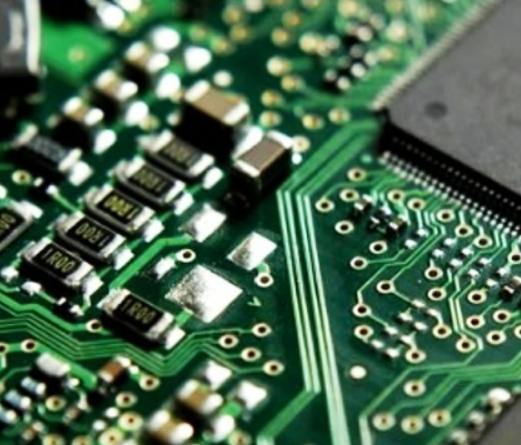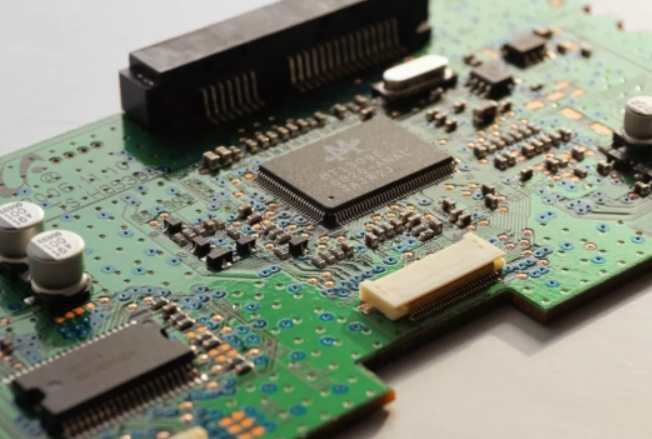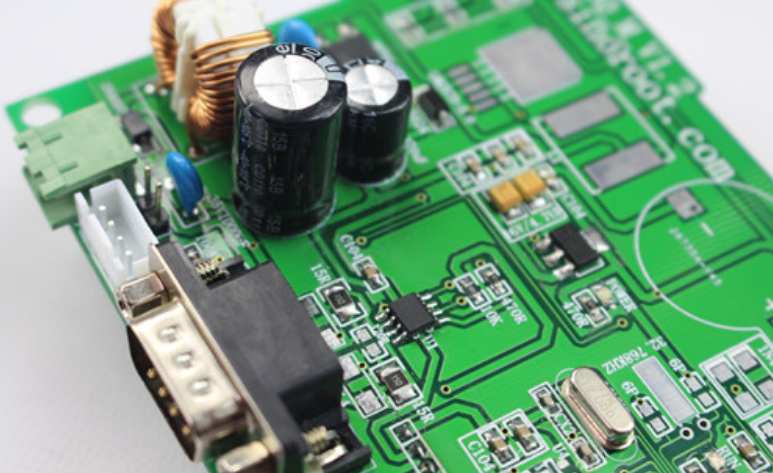
The quality of reflow welding is affected by many factors, the most important factor is the temperature curve of reflow furnace and the ingredient number of solder paste in the process of electronic production. Now commonly used high-performance reflow furnace, has been more convenient to accurately control, adjust the temperature curve, in contrast, in the trend of high density and miniaturization, solder paste printing has become the key to reflow quality, solder paste, template and printing three factors can affect the quality of solder paste printing.
1, the phenomenon of stele
In reflow welding, chip components often appear the phenomenon of standing up, known as stele, also known as suspension bridge, Manhattan phenomenon, which is a defect often occurs in reflow welding process.
Cause: The root cause of the stele phenomenon is the unbalanced wetting force on both sides of the components, so the torque at both ends of the components is also unbalanced, which leads to the stele phenomenon.
The following situations will cause uneven wetting force on both sides of the components during reflow welding.
1. The design and layout of the welding pad are unreasonable.
If the design and layout of the pad has the following defects, it will cause the wetting force imbalance on both sides of the components.
One of the two sides of the components is connected with the ground wire or one side of the pad area is too large, and the heat capacity of the two ends of the pad is not uniform
The temperature difference on PCB circuit board surface is too large, resulting in uneven heat absorption on both sides of the component pad;
Large devices QFP, BGA, radiator around small chip components at both ends of the welding pad will appear uneven temperature phenomenon.
Solution: improve pad design and layout
2, solder paste and solder paste printing.
The activity of the solder paste is not high or the weldability of the components is poor. After the solder paste is melted, the surface tension is not the same, which will also cause the imbalance of the wetting force of the solder pad. The printing amount of solder paste in two pads is not uniform. One side of the solder paste will absorb more heat and melt time lag, so that the wetting force is unbalanced.
Solution: Choose solder paste with higher activity, improve solder paste printing parameters, especially the template window size.
3. Patch.
Uneven force in the Z-axis direction will lead to uneven depth of components immersed in solder paste, and uneven wetting force on both sides will be caused by time difference during melting. Components deviating from the pad will directly lead to stele.
Solution: Adjust the process parameters of the patch machine.
4, furnace temperature curve.
The working curve of PCB heating is not correct, so that the temperature difference on the board surface is too large, usually reflow furnace body is too short and too few temperature zone will cause these defects.
Solution: Adjust the appropriate temperature curve according to each product.
5. Oxygen concentration in N2 reflow welding.
The use of N2 protective reflow welding will increase the wetting power of the solder, but more and more reports indicate that the phenomenon of stele is increased when the oxygen content is too low. It is generally considered that the most suitable oxygen content is (100-500) ×10-6mg/m3.
2. Tin beads
Tin bead is one of the common defects in reflow welding, which has many reasons, not only affects the appearance but also causes the bridge.
Tin beads can be divided into two categories, one appears on the side of the chip components, often as an independent ball; The other type appears around the IC pin, in the shape of scattered beads.
1. The temperature curve is incorrect.
The reflow curve can be divided into four sections, which are preheating, insulation, reflow and cooling. The purpose of preheating and insulation is to make the PCB surface temperature rise to 150℃ within 60-90s, and hold the PCB for about 90s, which can not only reduce the thermal shock of PCB and components, but also ensure that the solvent energy of solder paste is partially volatilized, so as to avoid splashing caused by too much solvent in reflow welding, resulting in solder paste rushing out of the pad and forming tin beads.
Solution: Pay attention to heating rate, and take moderate preheating so that there is a good platform to make most of the solvent volatilize.
2. The quality of solder paste.
The metal content in the solder paste is usually (90±0.5) %. Too low the metal content will lead to too much flux, so too much flux will cause flying beads because of the preheating stage is not easy to volatilize.
Increased water vapor and oxygen content in solder paste can also cause flying beads. Because solder paste is usually refrigerated, when removed from the refrigerator, there is no guarantee of recovery time, so it will lead to the entry of water vapor; In addition, the lid of the solder paste bottle should be tightly closed after each use. If it is not tightly covered in time, it will also lead to the entry of water vapor.

After the solder paste printed on the template is completed, the remaining part should be dealt with separately. If it is put back into the original bottle, it will cause the solder paste in the bottle to deteriorate and also produce tin beads.
Solution: Choose high quality solder paste, pay attention to the storage and use requirements of solder paste.
3. Printing and patch
In the printing process of solder paste, because there will be deviation between the template and the pad, if the deviation is too large, the solder will be soaked to the outside of the pad, and the tin beads will easily appear after heating. In addition, poor printing working environment will also lead to the generation of tin beads, the ideal printing environment temperature is (25±3) ℃, relative humidity is 50% ~ 65%.
Solution: carefully adjust the clamping of the template to prevent loosening; Improve the printing work environment.
The Z-axis pressure in the patching process is also an important cause of tin beads, which is often not easy to attract people's attention. Some of the Z-axis head of the patching machine is located according to the thickness of the components. If the height of the Z-axis is improperly adjusted, it will cause the solder paste to be extruded to the outside of the solder plate when the components are attached to the PCB, and this part of the solder paste will form tin beads when welding. The size of the tin bead produced in this case is slightly larger.
Solution: Adjust the Z-axis height of the patch machine again.
The thickness of the template and the size of the opening. Excessive template thickness and opening size will lead to an increase in the amount of solder paste, and will also cause solder paste to spill out of the plate, especially if the template is manufactured using chemical corrosion methods.
Solution: Choose the appropriate thickness of the template and the design of the opening size, the general template opening area is 90% of the size of the solder plate, will improve the tin bead situation.
4, core suction phenomenon
Core-pulling phenomenon, also known as core-pulling phenomenon, is one of the common welding defects, which often occurs in gas phase reflow welding. The core suction phenomenon is that the solder leaves the pad and goes up along the pin to between the pin and the chip body, which usually forms a serious virtual welding phenomenon.
Cause:
The main reason is that the thermal conductivity of the component pin is large, so the temperature rises rapidly. As a result, the solder gives priority to wetting the pin, and the wetting force between the solder and the pin is far greater than that between the solder and the pad. In addition, the upwarping of the pin will aggravate the occurrence of core suction.
The solution:
For gas phase reflow welding, SMA should be fully preheated before being put into gas phase furnace.
The solderability of PCB pad should be carefully checked. PCB with poor solderability should not be used in production.
Pay full attention to the coplanicity of components, and devices with poor coplanicity should not be used in production.
In infrared reflow welding, the organic flux in PCB substrate and solder is a good absorbing medium for infrared ray, while the pin can partly reflect infrared ray. Therefore, solder is preferentially melted, and the wetting force between solder and pad is greater than that between solder and pin. Therefore, solder will not rise along the pin, and the probability of core absorption phenomenon is much smaller.
5. Bridge
Bridging is one of the common defects in SMT production. It will cause short circuit between components, which must be repaired.
There are many reasons for bridging, and four common ones are as follows:
1, solder paste quality problem.
The metal content in the solder paste is high, especially after too long printing time, it is easy to increase the metal content, resulting in IC pin bridge;
The viscosity of the solder paste is low, and it flows to the outside of the plate after preheating.
The solder paste slumps poorly and flows out of the pan after preheating.
Solution: Adjust the ratio of solder paste or use good quality solder paste.
2. Printing system.
Printing machine repeat accuracy is poor, alignment is not uniform (steel plate alignment is not good, PCB alignment is not good), resulting in solder paste printing to the outside of the welding plate, more in the production of fine spacing QFP;
Incorrect plate window size and thickness design, as well as PCB bonding pad design Sn-Pb alloy coating uneven, resulting in excessive solder paste.
Solution: Adjust the printing press and improve the coating layer of PCB bonding pad.
3, paste.
Sticking pressure is too large, the solder paste pressure after the overflow is the most common reason in production. In addition, the accuracy of the patch is not enough, the displacement of components, IC pin deformation and so on are also easy to lead to bridge.
4. Preheat.
The temperature rise of reflow furnace is too fast, and the solvent in solder paste has no time to volatilize.
Solution: Adjust the height of Z axis of the SMT machine and the heating rate of reflow welding furnace.






